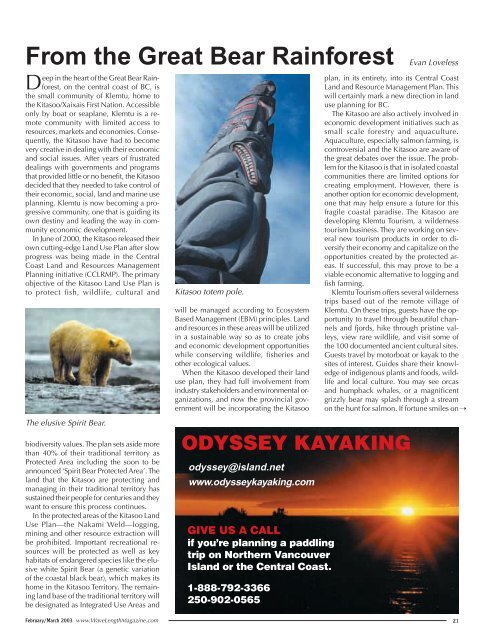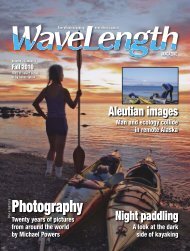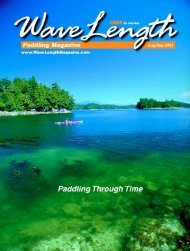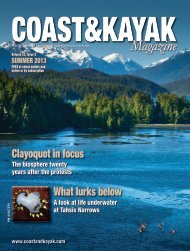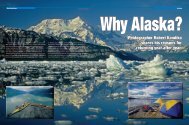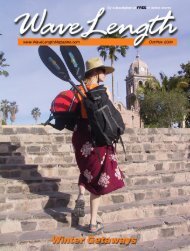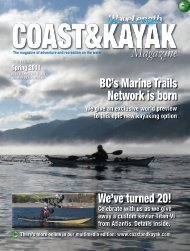download - WaveLength Paddling Magazine
download - WaveLength Paddling Magazine
download - WaveLength Paddling Magazine
You also want an ePaper? Increase the reach of your titles
YUMPU automatically turns print PDFs into web optimized ePapers that Google loves.
From the Great Bear Rainforest<br />
Deep in the heart of the Great Bear Rainforest,<br />
on the central coast of BC, is<br />
the small community of Klemtu, home to<br />
the Kitasoo/Xaixais First Nation. Accessible<br />
only by boat or seaplane, Klemtu is a remote<br />
community with limited access to<br />
resources, markets and economies. Consequently,<br />
the Kitasoo have had to become<br />
very creative in dealing with their economic<br />
and social issues. After years of frustrated<br />
dealings with governments and programs<br />
that provided little or no benefit, the Kitasoo<br />
decided that they needed to take control of<br />
their economic, social, land and marine use<br />
planning. Klemtu is now becoming a progressive<br />
community, one that is guiding its<br />
own destiny and leading the way in community<br />
economic development.<br />
In June of 2000, the Kitasoo released their<br />
own cutting-edge Land Use Plan after slow<br />
progress was being made in the Central<br />
Coast Land and Resources Management<br />
Planning initiative (CCLRMP). The primary<br />
objective of the Kitasoo Land Use Plan is<br />
to protect fish, wildlife, cultural and<br />
The elusive Spirit Bear.<br />
biodiversity values. The plan sets aside more<br />
than 40% of their traditional territory as<br />
Protected Area including the soon to be<br />
announced ‘Spirit Bear Protected Area’. The<br />
land that the Kitasoo are protecting and<br />
managing in their traditional territory has<br />
sustained their people for centuries and they<br />
want to ensure this process continues.<br />
In the protected areas of the Kitasoo Land<br />
Use Plan—the Nakami Weld—logging,<br />
mining and other resource extraction will<br />
be prohibited. Important recreational resources<br />
will be protected as well as key<br />
habitats of endangered species like the elusive<br />
white Spirit Bear (a genetic variation<br />
of the coastal black bear), which makes its<br />
home in the Kitasoo Territory. The remaining<br />
land base of the traditional territory will<br />
be designated as Integrated Use Areas and<br />
Kitasoo totem pole.<br />
will be managed according to Ecosystem<br />
Based Management (EBM) principles. Land<br />
and resources in these areas will be utilized<br />
in a sustainable way so as to create jobs<br />
and economic development opportunities<br />
while conserving wildlife, fisheries and<br />
other ecological values.<br />
When the Kitasoo developed their land<br />
use plan, they had full involvement from<br />
industry stakeholders and environmental organizations,<br />
and now the provincial government<br />
will be incorporating the Kitasoo<br />
ODYSSEY KAYAKING<br />
odyssey@island.net<br />
www.odysseykayaking.com<br />
GIVE US A CALL<br />
if you’re planning a paddling<br />
trip on Northern Vancouver<br />
Island or the Central Coast.<br />
1-888-792-3366<br />
250-902-0565<br />
Evan Loveless<br />
plan, in its entirety, into its Central Coast<br />
Land and Resource Management Plan. This<br />
will certainly mark a new direction in land<br />
use planning for BC.<br />
The Kitasoo are also actively involved in<br />
economic development initiatives such as<br />
small scale forestry and aquaculture.<br />
Aquaculture, especially salmon farming, is<br />
controversial and the Kitasoo are aware of<br />
the great debates over the issue. The problem<br />
for the Kitasoo is that in isolated coastal<br />
communities there are limited options for<br />
creating employment. However, there is<br />
another option for economic development,<br />
one that may help ensure a future for this<br />
fragile coastal paradise. The Kitasoo are<br />
developing Klemtu Tourism, a wilderness<br />
tourism business. They are working on several<br />
new tourism products in order to diversify<br />
their economy and capitalize on the<br />
opportunities created by the protected areas.<br />
If successful, this may prove to be a<br />
viable economic alternative to logging and<br />
fish farming.<br />
Klemtu Tourism offers several wilderness<br />
trips based out of the remote village of<br />
Klemtu. On these trips, guests have the opportunity<br />
to travel through beautiful channels<br />
and fjords, hike through pristine valleys,<br />
view rare wildlife, and visit some of<br />
the 100 documented ancient cultural sites.<br />
Guests travel by motorboat or kayak to the<br />
sites of interest. Guides share their knowledge<br />
of indigenous plants and foods, wildlife<br />
and local culture. You may see orcas<br />
and humpback whales, or a magnificent<br />
grizzly bear may splash through a stream<br />
on the hunt for salmon. If fortune smiles on➝<br />
February/March 2003 www.<strong>WaveLength</strong><strong>Magazine</strong>.com<br />
21


